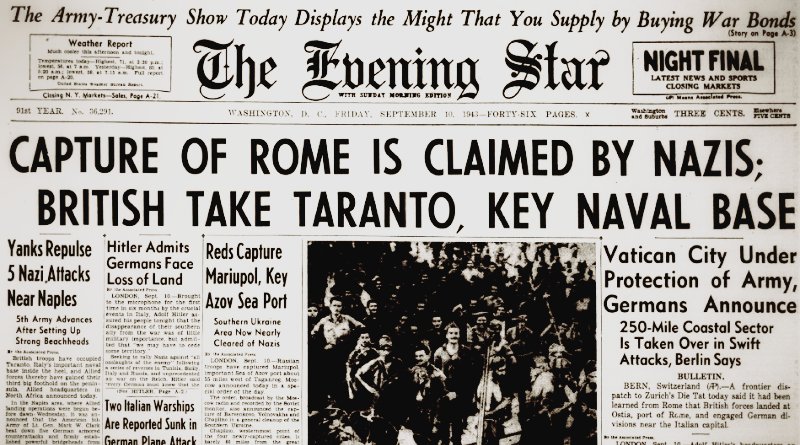World War II Chronicle: September 10, 1943
Click here for TODAY’S NEWSPAPER
The Germans now control Rome… George Fielding Eliot column on page 10… Sports on page 18.
Roving Reporter by Ernie Pyle
SOMEWHERE IN SICILY — It was an hour after daylight when I returned to the German-blown highway crater which our Third Division engineers had been working on all night.
It really didn’t look as though they’d accomplished much, but an engineer’s eye would have seen that the groundwork was all laid. They had drilled and blasted two holes far down the jagged slope. These were to set upright timbers into so they wouldn’t slide downhill when weight was applied.
The far side of the crater had been blasted out and leveled off so it formed a road across about one-third of the hole. Small ledges had been jack-hammered at each end of the crater and timbers bolted into them forming abutments of the bridge that was to come.
Steel hooks had been imbedded deep into the rock to hold wire cables. At the tunnel mouth lay great timbers, two feet square, and other long pieces of timber bolted together in the middle to make them long enough to span the hole.
At 10 a.m., the huge uprights were slid down the bank, caught by a group of men clinging to the steep slope below, and their ends worked into the blasted holes. Then they were brought upright by men on the banks, pulling on ropes tied to them. Similar heavy timbers were slowly and cautiously worked out from the bank until their tops rested on the uprights.
A half-naked soldier doing practically a wire-walking act. edged out over the timber and bored a long hole down through two timbers with an air-driven bit. Then he hammered a steel rod into it, tying them together.
Others added more bracing, nailing them together with huge spikes driven in by sledge hammers. Then they slung a steel cable from one end of the crater to the other, wrapped it around the upright stanchions and drew it tight with a winch mounted on a truck.
Now came the coolie scene as 20 shirtless, sweating soldiers to each of the long-spliced timbers carried and slid them out across the chasm, resting them on the two wooden spans just erected. They sagged in the middle, but still the cable beneath took most of the strain. They laid 10 of these across and the bridge began to take shape. Big stringers were bolted down, heavy flooring was carried on and nailed to the stringers. Men built up the approaches with stones. The bridge was almost ready.
Around 11 a.m., jeeps had begun to line up at the far end of the tunnel. They carried reconnaissance platoons, machine gunners and boxes of ammunition. They’d been given No. 1 priority to cross the bridge.
First, Maj. Gen. Truscott arrived again and sat on a log talking with the engineering officers, waiting patiently. Around dusk of the day before, the engineers had told me they’d have jeeps across the crater by noon the next day. It didn’t seem possible at the time, but they knew whereof they spoke.
But even they will have to admit it was pure coincidence that the first jeep rolled cautiously across the miracle bridge at high noon, to the very second.
In that first jeep was Gen. Truscott and his driver, facing a 200-foot tumble into the sea if the bridge gave way. The engineers had insisted they send a test jeep across first. But when he saw it was ready, the General just got in and went. It wasn’t done dramatically but it was a sort of dramatic thing. It showed that the “Old Man” had complete faith in his engineers. I heard soldiers speak of it appreciatively for an hour.
Jeeps snaked across the rickety bridge to watch and measure the sag under each load. The bridge squeaked and bent as the jeeps crept over. But it held, and nothing else matters. When the vital spearhead of the division got across, traffic was halted again and the engineers were given three hours to strengthen the bridge for heavier traffic by inserting a third heavy upright in the middle.
That, too, was a terrific job but at exactly 4 p.m. the first 3-4 ton truck rolled across, and they kept putting over heavier and heavier loads until before dark a giant bulldozer was sent across, and after that, everything could follow.
The tired men began to pack their tools into trucks. Engineer officers who hadn’t been to sleep in 36 hours went back to their olive orchard to clean up. They had built a jerry bridge, a comical bridge, a proud bridge, but above all the kind of bridge that wins wars. And they had built it in one night and half a day. The General was mighty pleased.
Evening star. (Washington, D.C.), 10 September 1943. Chronicling America: Historic American Newspapers. Lib. of Congress.
https://chroniclingamerica.loc.gov/lccn/sn83045462/1943-09-10/ed-1/
